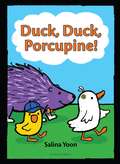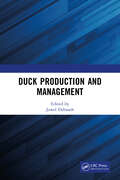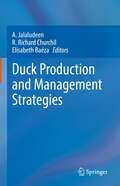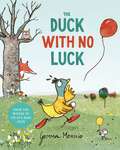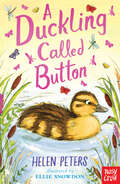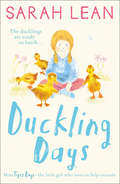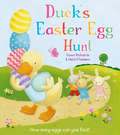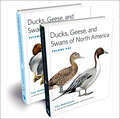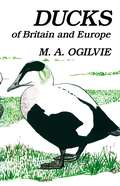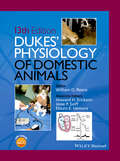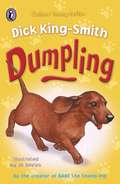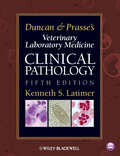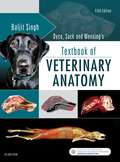- Table View
- List View
Duck-billed platypus (large print)
by RnibThis page shows an image of a side view of a duck-billed platypus with its head on the left of the page and a tail on the right of the page. There is a locator dot shown, which will be at the top left of the page when the image is the correct way up. On the centre left of the page is the animal's bill. It has two nostril holes showing. To the right is the head with one of its two round eyes showing. The body is to the right, the head flows into it without an apparent neck. Down from the front end of the body is the front leg. It is very short and has a large webbed foot. To the right of the body on the centre right of the page is its tail. This is broad and flat. Down from the tail is the rear leg which also has a webbed foot. The duck-billed platypus is a very unusual amphibious mammal. It lays eggs not live offspring. When the eggs hatch, the young are suckled like other mammals. The bill is not hard like a duck's but a soft flexible substance. They have no teeth. They grow to be 47 cm. They have only lived in Australia and nowhere else.
Duck-billed platypus (UEB contracted)
by RnibThis page shows an image of a side view of a duck-billed platypus with its head on the left of the page and a tail on the right of the page. There is a locator dot shown, which will be at the top left of the page when the image is the correct way up. On the centre left of the page is the animal's bill. It has two nostril holes showing. To the right is the head with one of its two round eyes showing. The body is to the right, the head flows into it without an apparent neck. Down from the front end of the body is the front leg. It is very short and has a large webbed foot. To the right of the body on the centre right of the page is its tail. This is broad and flat. Down from the tail is the rear leg which also has a webbed foot. The duck-billed platypus is a very unusual amphibious mammal. It lays eggs not live offspring. When the eggs hatch, the young are suckled like other mammals. The bill is not hard like a duck's but a soft flexible substance. They have no teeth. They grow to be 47 cm. They have only lived in Australia and nowhere else.
Duck-billed platypus (UEB uncontracted)
by RnibThis page shows an image of a side view of a duck-billed platypus with its head on the left of the page and a tail on the right of the page. There is a locator dot shown, which will be at the top left of the page when the image is the correct way up. On the centre left of the page is the animal's bill. It has two nostril holes showing. To the right is the head with one of its two round eyes showing. The body is to the right, the head flows into it without an apparent neck. Down from the front end of the body is the front leg. It is very short and has a large webbed foot. To the right of the body on the centre right of the page is its tail. This is broad and flat. Down from the tail is the rear leg which also has a webbed foot. The duck-billed platypus is a very unusual amphibious mammal. It lays eggs not live offspring. When the eggs hatch, the young are suckled like other mammals. The bill is not hard like a duck's but a soft flexible substance. They have no teeth. They grow to be 47 cm. They have only lived in Australia and nowhere else.
Duck, Duck, Porcupine! (A Duck, Duck, Porcupine Book)
by Salina YoonMeet Big Duck, Little Duck, and Porcupine, stars of the Geisel Honor-winning early reader series perfect for fans of Elephant & Piggie and Ballet Cat.Big Duck likes to boss around her younger brother, Little Duck, and she fancies herself the leader of their trio--when joined by their gentle friend Porcupine. Little Duck doesn't speak yet, but through his expressions and his actions, he shows that he has a better grasp on any situation than his older sister. Told entirely through dialogue and visual storytelling with subtle humor throughout, Little Duck ends up getting the trio out of whatever jam they are in.Moving into an exciting new paper over board reader format, Salina Yoon's early readers are perfect for fans of bestselling series like Elephant & Piggie and Ballet Cat, giving all her picture book fans a fantastic next step for reading fun.Don't miss these other stories by Salina Yoon!Duck, Duck, Porcupine seriesDuck, Duck, PorcupineMy Kite Is Stuck! And Other StoriesThat's My Book! And Other StoriesThe Penguin seriesPenguin and PineconePenguin in LovePenguin's Big AdventurePenguin on VacationPenguin and PumpkinPenguin's Christmas WishThe Bear and Floppy booksFoundStormy NightBear's Big Day
Duck, Duck, Porcupine! (A Duck, Duck, Porcupine Book #1)
by Salina YoonMeet Big Duck, Little Duck, and Porcupine, stars of the Geisel Honor-winning early reader series perfect for fans of Elephant & Piggie and Ballet Cat.Big Duck likes to boss around her younger brother, Little Duck, and she fancies herself the leader of their trio--when joined by their gentle friend Porcupine. Little Duck doesn't speak yet, but through his expressions and his actions, he shows that he has a better grasp on any situation than his older sister. Told entirely through dialogue and visual storytelling with subtle humor throughout, Little Duck ends up getting the trio out of whatever jam they are in.Moving into an exciting new paper over board reader format, Salina Yoon's early readers are perfect for fans of bestselling series like Elephant & Piggie and Ballet Cat, giving all her picture book fans a fantastic next step for reading fun.Don't miss these other stories by Salina Yoon!Duck, Duck, Porcupine seriesDuck, Duck, PorcupineMy Kite Is Stuck! And Other StoriesThat's My Book! And Other StoriesThe Penguin seriesPenguin and PineconePenguin in LovePenguin's Big AdventurePenguin on VacationPenguin and PumpkinPenguin's Christmas WishThe Bear and Floppy booksFoundStormy NightBear's Big Day
Duck Production and Management
by Jowel DebnathThis book covers nearly all the aspects of duck rearing system with various duck genetic resources of India, their nutritional requirements, care management, diseases and prevention, slaughter, grading, packaging of meat, nutritional importance of meat & egg and integrated farming. To make this book more competent for farmers, enlisted certain drugs for treatment of different diseases of duck and vaccination schedule has also been included in the text. References have been included in this book to refer the interested reader for details understanding of duck rearing system. The language is kept simple and lucid for ease of understanding. This book will find right place in the hands of researchers, veterinary graduates, students of the animal sciences and farmers who are engaged in duck farming.
Duck Production and Management
by Jowel DebnathThis book covers nearly all the aspects of duck rearing system with various duck genetic resources of India, their nutritional requirements, care management, diseases and prevention, slaughter, grading, packaging of meat, nutritional importance of meat & egg and integrated farming. To make this book more competent for farmers, enlisted certain drugs for treatment of different diseases of duck and vaccination schedule has also been included in the text. References have been included in this book to refer the interested reader for details understanding of duck rearing system. The language is kept simple and lucid for ease of understanding. This book will find right place in the hands of researchers, veterinary graduates, students of the animal sciences and farmers who are engaged in duck farming.
Duck Production and Management Strategies
by A. Jalaludeen R. Richard Churchil Elisabeth BaézaThis book provides comprehensive insights into the field of duck production and management. It presents a complete overview of different aspects of duck production with particular emphasis on rearing systems. The book reviews current knowledge on the anatomy, physiology, genetics, breeding, nutrition, incubation, and hatching practices of ducks. It further discusses the common diseases of duck, their treatment regime, and prevention strategies. The book additionally examines all aspects of the global duck industry, the constraints, and the recommendations. It also explores nutrient requirements and feed evaluation for duck and evaluates nutrition's influence on the gut microbiome. Towards the end, the book presents the latest genomic applications, including high throughput sequencing and various bioinformatics tools in duck production. This book serves as an essential resource for duck industry practitioners, researchers, and students.
The Duck with No Luck
by Gemma MerinoWhat's a fed-up duck who feels all out of luck supposed to do? Go and ask a wise owl for help, of course! But watch out for the hungry Fox . . .From the award-winning Gemma Merino, author of the The Crocodile Who Didn't Like Water, The Duck With No Luck is a funny, uplifting and reassuring tale about how to tackle the ups and downs of life, take a more positive look at things and appreciate all you have.After a particularly unlucky moment, Duck has had enough! Heading off to ask Wise Owl why he's so unlucky, he comes across a lonely Swan, a hungry Fox and a bare tree, all looking for answers of their own. Will Wise Owl's advice help Duck to find his luck after all? And has he just been looking in the wrong place all along?
A Duckling Called Button
by Helen PetersThe second title in a fantastic series of animal stories for younger readers by Waterstones Children's Book Prize-shortlisted author Helen Peters, with beautiful black-and-white illustrations by Ellie Snowdon. When a nesting duck is killed in a terrible accident, Jasmine and her best friend Tom rescue the eggs and try to hatch them in an incubator. It's a risky business but soon Button is running around, getting into scrapes. Until the day he gets into a scrape with no escape... Brilliant storytelling that will make you laugh and cry, this is Dick King-Smith for a new generation. Look out for Jasmine's other adventures! A Piglet Called Truffle A Sheepdog Called Sky
Duckling Days (Tiger Days #4)
by Sarah LeanMeet animal lover, Tiger Days! A heart-warming series about animals, friendship and adventure, by bestselling author Sarah Lean. Beautiful black-and-white illustrations throughout.
Duck's Easter Egg Hunt
by Dawn RichardsWith gorgeously colourful illustrations and a gloriously glittery cover, this book is PERFECT for sharing over a delicious chocolate egg!Duck is so excited about the Easter egg hunt she's organised that she loses her own precious egg. OH NO, DUCK!!! Duck is devastated, but all her friends (including three little bunnies: Hoppy, Poppy and Floppy) join together to help her. Children will delight in spotting the hidden eggs and helping the animals to help poor Duck.
Ducks, Geese, and Swans of North America
by Guy BaldassarreDucks, Geese, and Swans of North America has been hailed as a classic since the first edition was published in 1942. A must-have for professional biologists, birders, waterfowl hunters, decoy collectors, and wildlife managers, this fully revised and updated edition provides definitive information on the continent's forty-six species. Maps of both winter and breeding ranges are presented with stunning images by top waterfowl photographers and the acclaimed original artwork of Robert W. (Bob) Hines. Originally authored by F. H. Kortright and later revised by Frank Bellrose, this latest edition, which has been meticulously updated by renowned waterfowl biologist Guy Baldassarre, continues the legacy of esteemed authors. Each species account contains in-depth sections on: • identification• distribution• migration behavior• habitat• population status• breeding biology• rearing of young• recruitment and survival• food habits and feeding ecology • molts and plumages• conservation and management To facilitate identification, the species accounts also include detailed illustrations of wings. An appendix contains comparative illustrations of ducklings, goslings, and cygnets.This edition of Ducks, Geese, and Swans consists of two volumes, printed in full color, and packaged in a slipcase, along with a CD containing references and additional maps.
Ducks, Geese, and Swans of North America
by Guy BaldassarreDucks, Geese, and Swans of North America has been hailed as a classic since the first edition was published in 1942. A must-have for professional biologists, birders, waterfowl hunters, decoy collectors, and wildlife managers, this fully revised and updated edition provides definitive information on the continent's forty-six species. Maps of both winter and breeding ranges are presented with stunning images by top waterfowl photographers and the acclaimed original artwork of Robert W. (Bob) Hines. Originally authored by F. H. Kortright and later revised by Frank Bellrose, this latest edition, which has been meticulously updated by renowned waterfowl biologist Guy Baldassarre, continues the legacy of esteemed authors. Each species account contains in-depth sections on: • identification• distribution• migration behavior• habitat• population status• breeding biology• rearing of young• recruitment and survival• food habits and feeding ecology • molts and plumages• conservation and management To facilitate identification, the species accounts also include detailed illustrations of wings. An appendix contains comparative illustrations of ducklings, goslings, and cygnets.This edition of Ducks, Geese, and Swans consists of two volumes, printed in full color, and packaged in a slipcase, along with a CD containing references and additional maps.
Ducks of Britain and Europe (Poyser Monographs)
by M. A. OgilvieThe forty-two species or subspecies of ducks which occur in Europe, including eleven vagrants from North America or Asia, are the subject of this book. Its author is an accepted authority on ducks and geese, and has been a member of the research staff of the Wildfowl Trust at Slimbridge since 1960.Most birdwatchers consider ducks to be especially attractive and interesting birds, and many species of ducks are also the legitimate quarry of wildfowlers. Both groups need to identify the species quickly and accurately, and almost half of the book is devoted to identification, offering a far more detailed account than is to be found in any of the field guides. There are detailed descriptions, species by species, of the adult males and females, immature birds, eclipse males, and downy young - voice, too, is dealt with - and full-colour plates of males and females show the flight patterns, so important for correct species identification.The habits of European ducks are treated in chapters on behaviour and ecology, breeding biology, distribution and status, and the ever-fascinating topic of migration and navigation. The distribution chapter has maps showing the summer and winter ranges in Europe, North Africa, the Middle East and Central Russia, for 24 species.?A final chapter considers the present day threats to ducks and their wetland habitats, and the conservation measures being taken to combat the threats.The colour plates and more than 80 line drawings in the text are by Carol Ogilvie, the author's wife.Jacket illustration by Carol Ogilvie
Ducks of Britain and Europe (Poyser Monographs #116)
by M. A. OgilvieThe forty-two species or subspecies of ducks which occur in Europe, including eleven vagrants from North America or Asia, are the subject of this book. Its author is an accepted authority on ducks and geese, and has been a member of the research staff of the Wildfowl Trust at Slimbridge since 1960.Most birdwatchers consider ducks to be especially attractive and interesting birds, and many species of ducks are also the legitimate quarry of wildfowlers. Both groups need to identify the species quickly and accurately, and almost half of the book is devoted to identification, offering a far more detailed account than is to be found in any of the field guides. There are detailed descriptions, species by species, of the adult males and females, immature birds, eclipse males, and downy young - voice, too, is dealt with - and full-colour plates of males and females show the flight patterns, so important for correct species identification.The habits of European ducks are treated in chapters on behaviour and ecology, breeding biology, distribution and status, and the ever-fascinating topic of migration and navigation. The distribution chapter has maps showing the summer and winter ranges in Europe, North Africa, the Middle East and Central Russia, for 24 species.?A final chapter considers the present day threats to ducks and their wetland habitats, and the conservation measures being taken to combat the threats.The colour plates and more than 80 line drawings in the text are by Carol Ogilvie, the author's wife.Jacket illustration by Carol Ogilvie
Ducks (UEB uncontracted)
by Adrian FarnsworthThe first page shows an image of a duck followed by three small ducklings shown from the side. They are all facing and paddling to the left. The second page shows an image of a diving duck shown from the side, facing and paddling to the left.
Dukes' Physiology of Domestic Animals
by Howard H. Erickson Jesse P. Goff Etsuro E. UemuraThis fully revised new edition of the classic reference on domestic animal physiology provides detailed descriptions of animal function and dysfunction, with an emphasis on clinical relevance and pedagogical features to enhance learning. • Presents in-depth, comprehensive descriptions of domestic animal function and dysfunction • Emphasizes clinical relevance, with clinical correlations, notes of relevance, and self-assessment questions featuring situations likely to be faced in practice • Offers pedagogical features, including chapter outlines and introductions, key terms throughout the book, additional images, questions to enhance learning, and self-assessment exercises • Distills the most useful information for ease of use, with improved continuity and reduced repetition • Includes a companion website offering review questions and answers and the figures from the book in PowerPoint
Dukes' Physiology of Domestic Animals
by Howard H. Erickson Jesse P. Goff Etsuro E. UemuraThis fully revised new edition of the classic reference on domestic animal physiology provides detailed descriptions of animal function and dysfunction, with an emphasis on clinical relevance and pedagogical features to enhance learning. • Presents in-depth, comprehensive descriptions of domestic animal function and dysfunction • Emphasizes clinical relevance, with clinical correlations, notes of relevance, and self-assessment questions featuring situations likely to be faced in practice • Offers pedagogical features, including chapter outlines and introductions, key terms throughout the book, additional images, questions to enhance learning, and self-assessment exercises • Distills the most useful information for ease of use, with improved continuity and reduced repetition • Includes a companion website offering review questions and answers and the figures from the book in PowerPoint
Dumm wie ein Fisch?: Die überraschende Intelligenz unter Wasser
by Horst BleckmannGegenüber den Säugetieren werden Fische häufig unterschätzt und als weniger komplexe Organismen abgetan. Um diesen voreiligen Schluss zu entkräften, präsentiert Ihnen Horst Bleckmann die hochentwickelten kognitiven Fähigkeiten der Fische.Wussten Sie z.B., dass Fische mit ca. 30.000 Arten die größte Gruppe aller Wirbeltiere stellen und alle aquatischen Lebensräume besiedeln? Für diese immense Leistung haben sie eine Vielzahl von hochspezialisierten Sinnessystemen und Verhaltensweisen entwickelt. Nach neueren Forschungen verfügen Fische zudem nicht nur über äußerst raffinierte Sinnesorgane, sondern auch über hochentwickelte Zentralnervensysteme, die in ihrer Grundstruktur ähnlich aufgebaut sind wie die Gehirne der Säuger.Tauchen Sie in eine faszinierende Welt ein und lernen Sie alles über die verschiedenen Sinnessysteme der Fische kennen. Ein abschließendes Kapitel behandelt ergänzend die weltweite Bedrohung der Fische durch Gewässerverschmutzung, Querbauten in Fließgewässern und die Fischereiwirtschaft.
Dumpling
by Dick King-SmithA very funny animal story for young readers by award-winning writer Dick King-Smith.Dumpling wishes she was long and sausage-shaped like her two brothers and other dachshunds, instead of being short and stumpy. One day she goes to the woods and meets a witch's cat who grants Dumpling her wish, but the spell goes wrong and Dumpling gets longer and longer! She's very happy to return to her own shape again.
Duncan and Prasse's Veterinary Laboratory Medicine: Clinical Pathology
by Kenneth S. LatimerNow in full color throughout, Duncan and Prasse’s Veterinary Laboratory Medicine: Clinical Pathology, Fifth Edition offers a comprehensive overview of hematology, hemostasis, clinical chemistry, urinalysis, cytology, and reference intervals in a highly accessible outline format. With information on all major domestic species, the text is designed for the reader to quickly find answers to clinical questions. Taking a problem-solving approach to the interpretation of laboratory data, this book includes clinical cases to illustrate the concepts of laboratory data interpretation, with tables and key words to aid readers in locating and applying information. The fifth edition has been fully revised to reflect the latest knowledge, diagnostic methods, and practices in veterinary laboratory medicine. A companion website provides the images in PowerPoint and references linked to PubMed at www.wiley.com/go/latimer. Duncan and Prasse’s Veterinary Laboratory Medicine is an excellent quick reference for practicing veterinarians, veterinary students, clinical interns and residents, and pathology residents.
Duncan and Prasse's Veterinary Laboratory Medicine: Clinical Pathology
by Kenneth S. LatimerNow in full color throughout, Duncan and Prasse’s Veterinary Laboratory Medicine: Clinical Pathology, Fifth Edition offers a comprehensive overview of hematology, hemostasis, clinical chemistry, urinalysis, cytology, and reference intervals in a highly accessible outline format. With information on all major domestic species, the text is designed for the reader to quickly find answers to clinical questions. Taking a problem-solving approach to the interpretation of laboratory data, this book includes clinical cases to illustrate the concepts of laboratory data interpretation, with tables and key words to aid readers in locating and applying information. The fifth edition has been fully revised to reflect the latest knowledge, diagnostic methods, and practices in veterinary laboratory medicine. A companion website provides the images in PowerPoint and references linked to PubMed at www.wiley.com/go/latimer. Duncan and Prasse’s Veterinary Laboratory Medicine is an excellent quick reference for practicing veterinarians, veterinary students, clinical interns and residents, and pathology residents.
Dyce, Sack and Wensing's Textbook of Veterinary Anatomy - E-Book: Dyce, Sack and Wensing's Textbook of Veterinary Anatomy - E-Book
by Baljit Singh**Selected for Doody's Core Titles® 2024 with "Essential Purchase" designation in Veterinary Medicine** Gain the working anatomic knowledge that is crucial to your understanding of the veterinary basic sciences with Textbook of Veterinary Anatomy, 5th Edition. By focusing on the essential anatomy of each species, this well-established book details information directly applicable to the care of dogs, cats, horses, cows, pigs, sheep, goats, birds, and camelids — and points out similarities and differences among species. Each chapter includes a conceptual overview that describes the structure and function of an anatomic region, and new diagrams facilitate comprehension of bodily functions. - Comprehensive coverage of a multitude of species (dogs, cats, birds, horses, cows, pigs, sheep, goats, and now camelids) provides comparative anatomic information all in one resource. - Focuses on essential anatomy of each species, making this text ideal for any veterinary school curriculum that is covering the same amount of material in a reduced number of hours for course completion. - Clinical cases throughout relate actual cases to the study of anatomy to increase your understanding of how patients will present in practice. - Evolve site for students and instructors with a test bank, sample flash cards, and an image collection reinforces your understanding of veterinary anatomy — and helps you prepare for the NAVLE board exam. - Content is logically organized into two main sections – a general introduction to mammalian anatomy and a region-specific breakdown – to make studying more efficient and ensure greater understanding. - Flash cards and coloring book support the text and give you the opportunity to study anatomy in different ways to increase retention of what you have learned. - NEW and EXPANDED! New and updated diagrams further illustrate the anatomic structure and function of each species to facilitate comprehension of bodily functions, presenting the closest thing possible to an actual "hands-on" clinical experience. - EXPANDED! A 500-question Test Bank, designed for optimal NAVLE board exam preparation, lets you practice answering board-type questions. - UPDATED! New information on the anatomy of camelids, a species that is gaining importance in farm animal practice, provides an overview of the camelid anatomy and highlights any major differences compared to other species.
Dyce, Sack, and Wensing's Textbook of Veterinary Anatomy (Fifth Edition) (PDF)
by Keith Dyce Baljit SinghGain the working anatomic knowledge that is crucial to your understanding of the veterinary basic sciences with Textbook of Veterinary Anatomy, 5th Edition. By focusing on the essential anatomy of each species, this well-established book details information directly applicable to the care of dogs, cats, horses, cows, pigs, sheep, goats, birds, and camelids — and points out similarities and differences among species. Each chapter includes a conceptual overview that describes the structure and function of an anatomic region, and new diagrams facilitate comprehension of bodily functions.

